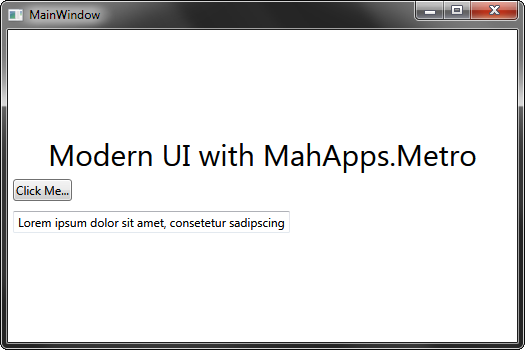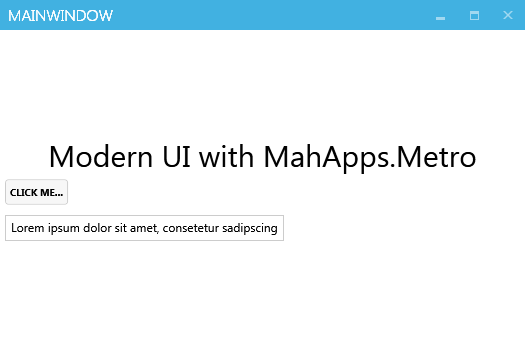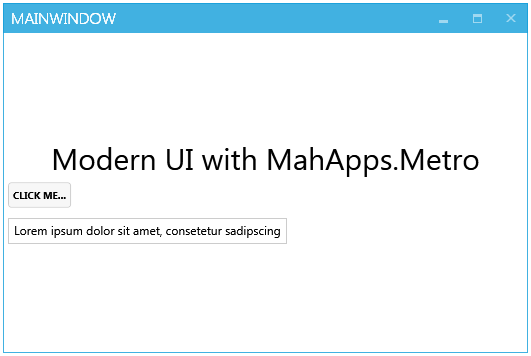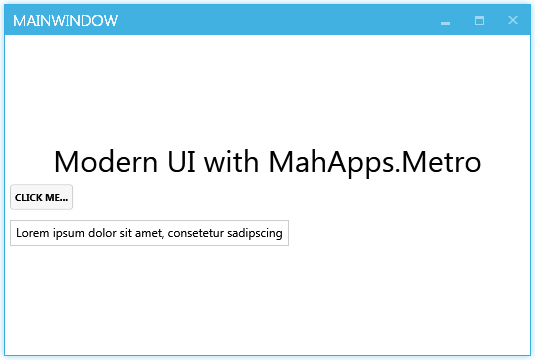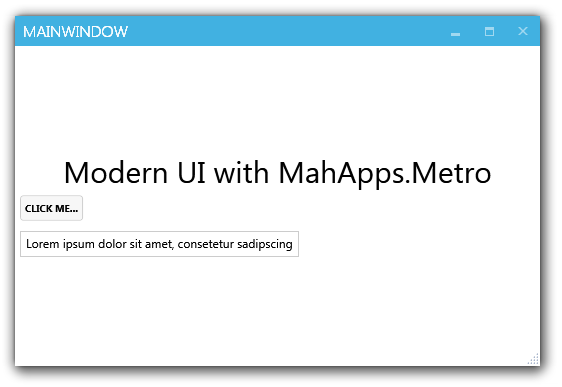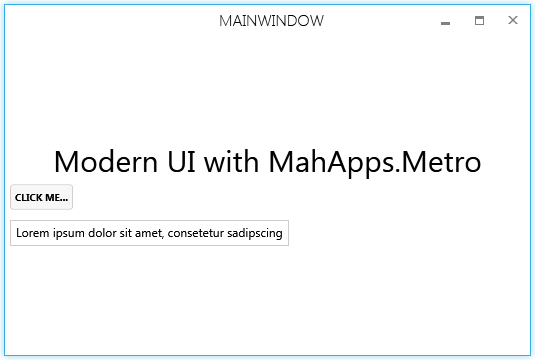Modern UI with MahApps.Metro
As a MahApps.Metro member I’am often confronted with questions like:
How do I start with MahApps.Metro?
How can I get the glow window?
Where is the shadow around the main window?
Now I could say, hey, we have a nice web page where you can look at the quick start guide, but I want to help users/developers everywhere.
So, this article will show you how fast it is to get a modern UI using MahApps.Metro.
Let’s go
First let’s create an empty WPF project with some simple controls.
1
2
3
4
5
6
7
8
9
10
11
12
13
14
15
<Window x:Class="MahAppsMetroSample.MainWindow"
xmlns="http://schemas.microsoft.com/winfx/2006/xaml/presentation"
xmlns:x="http://schemas.microsoft.com/winfx/2006/xaml"
Title="MainWindow"
Height="350" Width="525">
<Grid>
<StackPanel VerticalAlignment="Center">
<TextBlock Text="Modern UI with MahApps.Metro" HorizontalAlignment="Center" FontSize="30" />
<Button Content="Click Me..." HorizontalAlignment="Left" Margin="5" />
<TextBox Text="Lorem ipsum dolor sit amet, consetetur sadipscing" HorizontalAlignment="Left" Margin="5" />
</StackPanel>
</Grid>
</Window>
1
2
3
4
5
6
7
8
9
10
11
12
13
using System;
using System.Windows;
namespace MahAppsMetroSample
{
public partial class MainWindow : Window
{
public MainWindow()
{
InitializeComponent();
}
}
}
You can see that’s not a nice UI, so let’s change it.
You can install the latest stable MahApps.Metro library via the NuGet GUI (right click on your project, click Manage NuGet Packages, select Online and search for MahApps.Metro) or with the Package Manager Console:
1
Install-Package MahApps.Metro
If you need the latest alpha version, use this:
1
Install-Package MahApps.Metro -Pre
Now you should see:
1
2
3
4
5
Install-Package MahApps.Metro
Installing 'MahApps.Metro 0.14.0.0'.
Successfully installed 'MahApps.Metro 0.14.0.0'.
Adding 'MahApps.Metro 0.14.0.0' to MahAppsMetroSample.
Successfully added 'MahApps.Metro 0.14.0.0' to MahAppsMetroSample.
After installing, open up MainWindow.xaml and put this reference attribute inside the opening Window tag:
1
xmlns:Controls="clr-namespace:MahApps.Metro.Controls;assembly=MahApps.Metro"
or
1
xmlns:Controls="http://metro.mahapps.com/winfx/xaml/controls"
Now change the opening and closing Window tag to Controls:MetroWindow.
1
2
3
4
5
6
7
8
9
10
11
12
13
14
15
16
<Controls:MetroWindow x:Class="MahAppsMetroSample.MainWindow"
xmlns="http://schemas.microsoft.com/winfx/2006/xaml/presentation"
xmlns:x="http://schemas.microsoft.com/winfx/2006/xaml"
xmlns:Controls="http://metro.mahapps.com/winfx/xaml/controls"
Title="MainWindow"
Height="350" Width="525">
<Grid>
<StackPanel VerticalAlignment="Center">
<TextBlock Text="Modern UI with MahApps.Metro" HorizontalAlignment="Center" FontSize="30" />
<Button Content="Click Me..." HorizontalAlignment="Left" Margin="5" />
<TextBox Text="Lorem ipsum dolor sit amet, consetetur sadipscing" HorizontalAlignment="Left" Margin="5" />
</StackPanel>
</Grid>
</Controls:MetroWindow>
You’ll also need to modify the code behind MainWindow.xaml.cs file so that the base class for MainWindow matches the MetroWindow class of the XAML file.
1
2
3
4
5
6
7
8
9
10
11
12
13
using System;
using MahApps.Metro.Controls; // MahApps.Metro reference
namespace MahAppsMetroSample
{
public partial class MainWindow : MetroWindow
{
public MainWindow()
{
InitializeComponent();
}
}
}
All of MahApp.Metro's resources are contained within separate resource dictionaries. In order to adopt the MahApps.Metro accent and theme for most of the controls , you will need to add the following ResourceDictionaries to your App.xaml.
Make sure that all file names are spelled correct. They are Case Sensitive!
1
2
3
4
5
6
7
8
9
10
11
12
13
14
15
16
<Application x:Class="MahAppsMetroSample.App"
xmlns="http://schemas.microsoft.com/winfx/2006/xaml/presentation"
xmlns:x="http://schemas.microsoft.com/winfx/2006/xaml"
StartupUri="MainWindow.xaml">
<Application.Resources>
<ResourceDictionary>
<ResourceDictionary.MergedDictionaries>
<ResourceDictionary Source="pack://application:,,,/MahApps.Metro;component/Styles/Controls.xaml" />
<ResourceDictionary Source="pack://application:,,,/MahApps.Metro;component/Styles/Fonts.xaml" />
<ResourceDictionary Source="pack://application:,,,/MahApps.Metro;component/Styles/Colors.xaml" />
<ResourceDictionary Source="pack://application:,,,/MahApps.Metro;component/Styles/Accents/Blue.xaml" />
<ResourceDictionary Source="pack://application:,,,/MahApps.Metro;component/Styles/Accents/BaseLight.xaml" />
</ResourceDictionary.MergedDictionaries>
</ResourceDictionary>
</Application.Resources>
</Application>
The end result will look something like this:
You can choose between this available accents
Red,Green,Blue,Purple,Orange,Lime,Emerald,Teal,Cyan,Cobalt,Indigo,Violet,Pink,Magenta,Crimson,Amber,Yellow,Brown,Olive,Steel,Mauve,Taupe,Sienna
and themes
BaseLight,BaseDark
Borders
The MetroWindow has no border by default, but you can choose between 3 different borders.
A normal border
1
2
3
4
5
6
7
8
<Controls:MetroWindow x:Class="MahAppsMetroSample.MainWindow"
BorderBrush="{DynamicResource AccentColorBrush}"
BorderThickness="1"
Height="350" Width="525">
</Controls:MetroWindow>
A glow border
1
2
3
4
5
6
7
<Controls:MetroWindow x:Class="MahAppsMetroSample.MainWindow"
GlowBrush="{DynamicResource AccentColorBrush}"
Height="350" Width="525">
</Controls:MetroWindow>
A drop shadow
1
2
3
4
5
6
7
8
<Controls:MetroWindow x:Class="MahAppsMetroSample.MainWindow"
EnableDWMDropShadow="True"
ResizeMode="CanResizeWithGrip"
Height="350" Width="525">
</Controls:MetroWindow>
The clean window style
There is another clean window style for your application. Put only the CleanWindowStyleKey inside the opening MetroWindow tag and use the CleanWindow resource.
1
2
3
4
5
6
7
8
9
10
11
12
13
14
<Controls:MetroWindow x:Class="MahAppsMetroSample.MainWindow"
Style="{DynamicResource CleanWindowStyleKey}"
Height="350" Width="525">
<Window.Resources>
<ResourceDictionary>
<ResourceDictionary.MergedDictionaries>
<ResourceDictionary Source="pack://application:,,,/MahApps.Metro;component/Styles/Clean/CleanWindow.xaml" />
</ResourceDictionary.MergedDictionaries>
</ResourceDictionary>
</Window.Resources>
</Controls:MetroWindow>
The visual studio style
A simple style that looks like Visual Studio. To get this, put only the VSWindowStyleKey inside the opening MetroWindow tag and use the colors and style resource.
1
2
3
4
5
6
7
8
9
10
11
12
13
14
15
<Controls:MetroWindow x:Class="MahAppsMetroSample.MainWindow"
Style="{DynamicResource VSWindowStyleKey}"
Height="350" Width="525">
<Window.Resources>
<ResourceDictionary>
<ResourceDictionary.MergedDictionaries>
<ResourceDictionary Source="pack://application:,,,/MahApps.Metro;component/Styles/VS/Colors.xaml" />
<ResourceDictionary Source="pack://application:,,,/MahApps.Metro;component/Styles/VS/Styles.xaml" />
</ResourceDictionary.MergedDictionaries>
</ResourceDictionary>
</Window.Resources>
</Controls:MetroWindow>
That’s it!
The complete sample can be found on GitHub.
